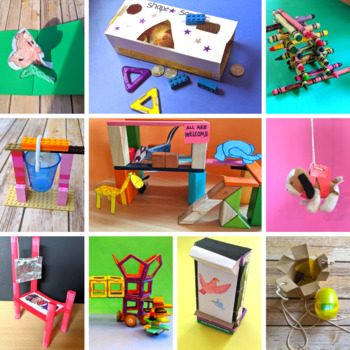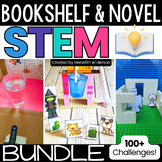STEM Activities for Read Aloud Books BUNDLE of 10
- Zip

Products in this Bundle (10)
showing 1-5 of 10 products
Also included in
- Literacy and STEM go hand-in-hand in this novel and read aloud STEM BUNDLE! These STEM activities bring these beloved stories to life! Perfect for your STEM library, makerspace, or to use as a literacy-based STEM curriculum.Each resource includes multiple STEM challenges so that you can either allowPrice $89.00Original Price $127.00Save $38.00
Description
Read alouds come ALIVE with STEM challenges! This set of STEM challenges provides 3-5 STEM challenge per story. That means that you can use the same book across multiple grade levels OR allow students to choose which STEM challenge to try. That also means if you want to do a Family STEM Night, you can set up stations for 2-3 of the stories and let families work together on the challenge of their choice.
Students will need to use skills such as taking measurements, creating stable structures, brainstorming, planning, and testing their designs. These challenges all follow the engineering design process (Ask - Imagine - Plan - Create - Improve).
CONTENTS
- A minimum of 3 STEM activities to go with EACH read aloud story, using materials you have on hand, such as paper, recyclables, office supplies, math manipulatives, or building blocks.
- Includes a variety of recording sheet options, such as graphic organizers and guided STEM challenge pages, plus self-evaluation/rubric.
- CCSS and NGSS Standards alignment
- Digital STEM journal option for Google Slides
Read Alouds Included* (*Please note that the activities for these read alouds are included, not the read alouds themseles! You will need to purchase a copy of the book or borrow one from your library.)
- What Do You Do with an Idea? by Kobi Yamada
- The Day the Crayons Quit by Drew Daywalt
- Made by Maxine by Ruth Spiro
- Violet the Pilot by Steve Breen
- Room on the Broom by Julia Donaldson
- Those Darn Squirrels by Adam Rubin
- Groundhog's Runaway Shadow by David Biedrzycki
- Frida Kahlo and Her Animalitos by Monica Brown
- Strictly No Elephants by Lisa Mantchev
- Olive, the Other Reindeer by J. Otto Seibold and Vivian Walsh
Who can use Bookshelf STEM Junior?
- Classroom teachers
- STEM specials teachers
- Librarians
- Makerspace facilitators
- Homeschool parents
- Community group leaders such as girl scouts, cub scouts, and 4H
- Camp counselors - make your summer or school vacation camp a literacy-filled affair
Teacher Reviews
★★★★★ "My students loved this the was the follow-up activity to our read-aloud! This product does not skimp on quality or content, and the attention to detail is evident. Thank you!"
★★★★★ "This was a great resource to use with the story. The students had a great time!"
★★★★★ "This is an adorable STEM activity and my students loved it. It was easy to use and so much fun! Thank you!!!"




